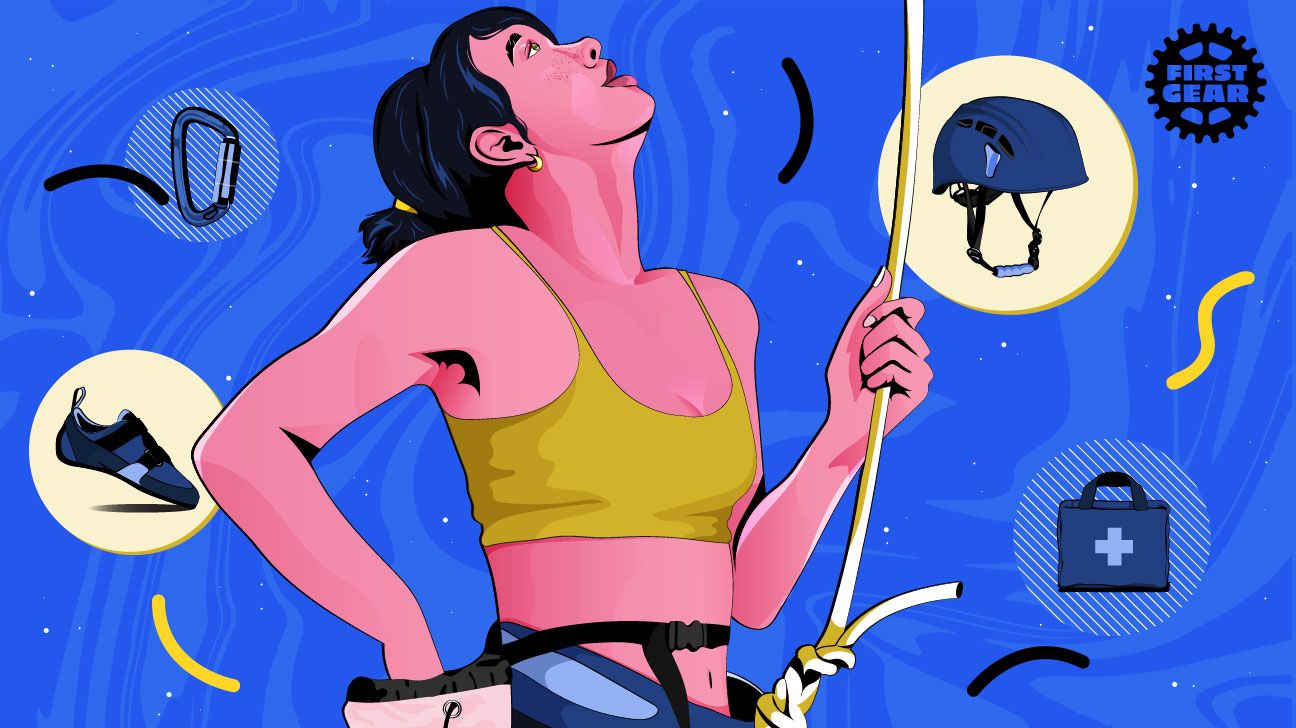
Climbing is a sport that boasts beaucoup benefits for your body and mind. NGL though, it can be a bit intimidating if you’re a beginner.
But don’t worry! We have the inside scoop on everything you need to know before you go. That includes all the deets on trip prep, safety, and of course, gear. Let’s get ready to rock!
Climbing kit essentials
Before you set off on a rockin’ adventure, you need to grab the right gear. Here are the essentials:
- climbing shoes
- helmet
- harness
- locking carabiner
- climbing ropes
- chalk and chalk bag
- first aid kit
FYI: Lots of indoor rock climbing gyms let you rent essential gear like harnesses, helmets, chalk, and shoes. But you should still call ahead of time to make sure.
Pre-climb research is really important before things get rocky. Here’s where to start.
Trip prep and research
Most indoor climbing spots will have staff that can help you gear up. They can also provide support as you get your climb on. Another perk of indoor climbing is that you don’t have to worry about weather conditions.
Prepping for an outdoor climbing trip is another story. Here’s a pre-climb checklist for beginners:
- Narrow it down. Consider the desired duration and intensity of your climb. This can help you pinpoint the right route for you. You should also think about how many people you’re going with and the type of weather you want.
- Find a route. There are tons of online resources to help you find a rad route. Check out online forums or social media groups in your area. A lot of climbing routes are organized by duration and experience level. You can also hit up your local indoor climbing gym and ask if they have any insider info.
- Know before you go. Even expert climbers should never just wing it. Come up with a detailed schedule for your trip. This should include the amount of miles you want to hike, the type of rocks you want to climb, and how many feet of elevation you want to tackle.
- Do a final review. A lot can change in the days before a trip. The night before your climb, review the itinerary, check the weather forecast, and go over your gear. When in doubt, don’t head out.
P.S. Be realistic about your goals! Start slow and work your way up to more advanced routes over time.
Weather
Like all outdoor sports, climbing can be weather dependent. So, def check the forecast in advance. Some folks love climbing in the rain. But this prob isn’t best for beginners. Rocks can get slippery, y’all. You should also avoid hella hot or super cold temps. Dehydration and frostbite are NOT a good time.
Keep in mind, working around the weather can get tricky if you plan a trip several months out. In that case, look up the weather statistics for that area. Then pick a window of dates that will likely have your average weather. While it can still be hit or miss, you might have better luck.
Physical condition
You don’t have to be in tip-top shape to enjoy a sweet climbing sesh. But it’s uber important to know your limits. Start with an easy, beginner’s course that you know you’ll likely get through. You should also take the time to do a warmup and stretch before each climb. Here are some great movement options:
- Gorilla Pose
- Standing hamstring stretch
- Posterior rotator cuff stretch
- Squatting leg-out groin stretch
- Rotating wrist and forearm stretch
- Tabletop Pose with a wrist variation
BTW, don’t forget the cooldown!
In general, climbing is super safe if you follow the rules and know your limits. But there are still some risks to keep in mind. Here are some safety dos and don’ts.
- Don’t climb alone. Beginner climbers should never go it alone. Always have at least one buddy with you at all times.
- Don’t get too high. Stick to beginner indoor routes if you’re new to climbing. You can level up once you get some experience points under your belt, erm, harness.
- Don’t get distracted. Don’t let the beautiful views distract you. It’s also a good idea to keep the chit-chat at the minimum. Instead, keep your focus on your hand and foot placement and take things one hold at a time.
- Do get a climbing guide. There’s no shame in the guide game! Lots of indoor climbing gyms offer lessons. You can also ask around for a trusted climbing pro that can take you out on an outdoor route. Just make sure they’re legit.
- Do always check your gear. Never climb with rusted, frayed, or damaged gear. Also, you should do routine safety checks throughout your climb. Make sure your knots are secure, and your harness fits comfortably.
Can you climb in jeans, a t-shirt, and sneakers? Maybe. Should you? NO. Climbing requires specific shoes, clothing, and equipment. Here’s the 411.
Clothing
You don’t need to deck yourself out for a Mount Everest-style trek. But you should follow these dress code tips for a safe, comfortable climb.
- Find your fit. Avoid super baggy clothes that can get in the way. Also make sure your shorts or pants can easily fit under your climbing harness.
- Flexibility. Don’t wear anything that can constrict your movement. You’ll need a full range of motion so you can fully extend your arms and legs.
- Durability. Rough surfaces and rocks can take their toll on clothes. So, opt for fabrics that won’t snag or rip easily. You can prob wear more standard gym gear for an indoor climbing course.
- Dress for the weather. Climbing in the cold requires extra layers of protection. Polyester blends are great for insulation. They can keep you warm and don’t absorb moisture like cotton. Wool is also a solid choice but can be a bit heavy.
Climbing shoes
The ideal climbing shoes depend on your terrain and skill level. Here are the footwear facts.
- Neutral. These sweet shoes offer a relaxed, comfortable fit. They’re a top choice for beginner climbers and are great for transitioning to hiking trails. Even experienced climbers like them for longer, multipitch climbs. Neutral shoes tend to have thick rubber soles and medium-to-stiff midsoles for solid support. The downside is that the thickness and relaxed fit aren’t ideal for tough overhanging routes.
- Moderate. Moderate climbing shoes have a downturned shape (aka a camber). They also have a slightly sticky rubber sole that’s thinner than neutral shoes. This makes them good for more technical routes and can help you slab routes and longer multipitch climbs. Just keep in mind, they’re not best for super overhang spots or challenging boulder routes.
- Aggressive. Aggressive shoes have a super snug fit and a downturned shape. They’re usually worn for single-pitch sport climbs and challenging indoor routes. The cons? They tend to be a lot less comfortable than neutral or moderate options. The downturned shape is also less flexible and won’t fit into cracks as easily.
P.S. Most climbing shoes are meant to be wornsans socks. But if you’re renting your shoes, you might want to wear some ultra-thin socks. You can also ask the vendor to spray the shoes with disinfectant before use. Foot fungus isn’t fun, fam.
Helmet
A high quality helmet is a must for any climb, even the easy indoor routes. It can protect you from serious head injuries caused by dropped equipment or falling rocks.
Harness
A harness helps secure you to your rope throughout your climb. It connects from the front to back and usually has a padded waist belt with two leg loops. The ideal harness should be snug but not so tight that it cuts off circulation to your lower body.
Locking carabiner
Carabiners connect you to your rope and gear. They come in four main shapes:
- Oval. Oval carabiners are the OG. They’re affordable, versatile, and can hold more gear than D-shape varieties. The downside is that they may not be as strong as other shapes.
- D shape. These are the strongest shape and can hold heavier loads. They have a larger gate opening than oval shaped varieties but tend to be a bit pricier.
- Pear shape. Like systematic D shapes, the pear shape has a large gate opening. This makes it easy to clip knots, gear, and ropes. The main cons are that they’re heavier and (generally) more expensive than other shapes.
- Asymmetric D. These uber-popular carabiners are slightly smaller than the regular D shape. They have a larger gate opening but may not have as much room as other carabiners.
Carabiners also have different gate (opening) types:
- Straight. Straight gates are the standard. They’re strong, durable, and versatile.
- Bent. These are great because they’re durable and can feature a key lock. They’re usually used at the rope end of quickdraws.
- Wire. Wire gates, which are non-locking, are made with a loop of stainless steel wire, which makes for a lightweight carabiner. They can help reduce gate lash and are less likely to freeze in cold temps. One con is that they tend to be less durable than bent or solid gates.
Climbing ropes
Climbing ropes are essential for keeping your climbs safe. The core layer provides the rope’s strength while an outer sheath makes it easier to grip and handle. They come in a huge variety of lengths and diameters. It all comes down to what you need them for.
A climbing rope is divided into two main categories: static and dynamic. Static ropes are used with anchoring systems, which can help haul gear up a wall. They’re also good for rappelling. Dynamic ropes have elasticity, which helps absorb your energy if you put pressure on it.
In general, a 70-meter climbing rope should be long enough for most climbs. But you should always bring extra rope just in case. You never want to run out midclimb.
Chalk and chalk bag
Chalk helps absorb moisture from your hands. This can help stop you from losing your grip or slipping. Most folks carry it as a powder and keep it in a bag. This can be attached to your harness for easy access.
First aid kit
A first aid kit is vital, especially if you’re climbing in the great outdoors. You can totes buy a prepackaged first aid kit online or at your local pharmacy. But a DIY pack might be best. That way you know you’ll have everything you need. This includes:
- gauze
- antiseptic wipes
- nonlatex gloves
- sterile gauze pads
- antibiotic ointment
- adhesive cloth tape
- absorbent compress dressings
- adhesive bandages in assorted sizes
- compression wrap (this is great for sprains and strains)
- any prescription or over-the-counter (OTC) medication you might need during the trip
Climbing is a super fun sport that’s great for your body and mind. It can boost confidence, increase strength, and is a darn good time. Just be sure to do your research ahead of time and remember safety protocols. Never climb alone, especially as a beginner. You should also stick to indoor routes only until you’re 10/10 sure you’re up for a bigger challenge outdoors.




